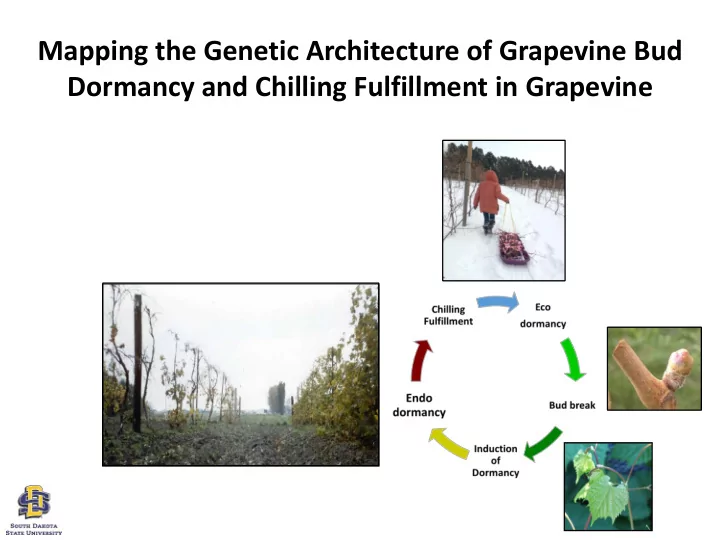

Mapping the Genetic Architecture of Grapevine Bud Dormancy and Chilling Fulfillment in Grapevine
Timing of dormancy induction and release are critical for sustainable grapevine production in changing climate. Develop and use a genetic model system to identify key factors controlling • Dormancy induction • Chilling Fulfillment • Budbreak timing • Fall, winter and spring freeze tolerance
Genetic System V. riparia Tolerates extreme low temperature Vitis riparia Seyval X Decreasing daylength induces Luby UMN dormancy and acclimation F1 population Seyval Screen for photoperiod Moderately freezing tolerant. induced dormancy Low temperature promotes dormancy. (Fennell SDSU) F1 (16_9_2) Single F1 Selfed (16-9-2) Intermediate photoperiod and dormancy responses F2 population F2 population Fruit quality, architecture, chilling (Fennell, Mathiason, Luby fulfillment, sex, dormancy induction, 2005) freezing tolerance, fruit ripening period
Phenotyping initiated prior to linkage map availability. • 110 individuals placed in 2 field locations (SD and MN) and original vines in controlled environment. • Photoperiod and low temperature response phenotypes measured in multiple years. • Field conditions and controlled temperature and photoperiod conditions.
Decreasing photoperiod induces growth cessation and early dormancy promoting winter survival. F2 population segregates for photoperiod and dormancy induction responses. summer lateral r=0.45 Summer lateral emergence r=0.53 Bud assay for dormancy Shoot tip abscission status Photoperiod Response QTLS identified on linkage groups 11, 12, 13 using SSR map (Garris et al. 2009)
Timing of dormancy induction influences timing of cold acclimation. F2 population segregates for acclimation responses. Lethal bud freezing temperature 0 LTE -0.00005 determined by monitoring low voltage -0.0001 temperature exotherm (LTE) using -0.00015 -0.0002 differential thermal analysis. (Mills et -0.00025 al., 2006). -0.0003 -25 -20 -15 -10 -5 °C Bud LTE measured in Nov., Dec., Jan. and Feb. in five dormant seasons. 30 30 Jan.14 # genotypes Nov.11 20 Feb.14 Dec.11 20 10 10 0 0 -35 -33 -31 -29 -27 -25 -23 -21 -35 -33 -31 -29 -27 -25 -23 -21 LTE °C LTE °C
• F2 map generated with 1,449 GBS markers from 424 individuals • 2424 cM in genetic length • Genome coverage 95% • Average distance between markers of 1.67 cM • Mapping protocol, YAN and malate metabolism QTLS & candidate genes
Photoperiod response QTLs are identified in multiple years in field and controlled environment conditions. Lateral growth cessation, tip abscission and dormancy induction QTLs explain 10 to 20% of phenotypic variation. Phenotypic No. of Linkage LOD Trait Group Position variation individuals score (R2) Mean lateral cessation 87 12 60.115 3.90 17.97 Critical Photoperiod GH Mean 106 11 98.89 5.57 14.80 Mean lateral cessation 106 12 55.45 4.03 10.20 Mean tip abscission 106 11 98.890 4.17 14.70 Dormancy, chilling fulfillment and LTE QTLs on linkage groups 4, 11, 13 or 18 explain 12 to 25% of phenotypic variation.
Haplotypes associated with the QTLs indicate genotypes in common between critical photoperiod, growth cessation, and long term winter survival. Vine Winter Survival Score AA – V. riparia grandparent H – Heterozygote BB – Seyval grandparent BB AA H
Summary • Multi-year dormancy and winter survival trait analyses identified multiple QTLs explaining 10 to 25% of phenotypic variation. • Use of haplotype analysis provides ability to select individuals that have multiple desired traits for further breeding or functional analysis. • F2 Population is being propagated and established in replicated planting to allow more rapid fruit, architecture and viticultural trait analyses.
Acknowledgements: • Dilmini Alahakoon • Mani Awale • Kalley Besler • Matthew Clark • Jim Luby • Jonathan Fresnedo- Ramirez • Shanshan Yang
Recommend
More recommend